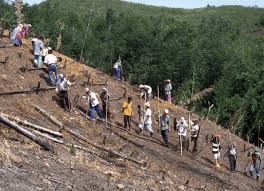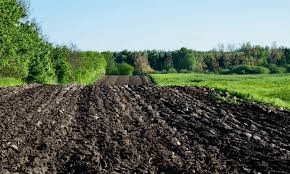The different forms of shifting cultivation described are in line with particular environments. Suffice to say that the types of shifting cultivation that exist vary from one region to another region, Some of the common types known are; slash-and-burn type of shifting cultivation, shifting cultivation and vegetative type of cultivation.
In addition, Shifting Cultivation is not just a farming system practiced by farmers but it is practiced because of some factors which have also been revealed in this article.
Types of Shifting Cultivation and their features

There are different types of Shifting Cultivation system that exist and being practiced by the farmers. Adebowale (2018) acknowledged that there are actually different types and these are explained below:
Vegetation systems
This is a type of Shifting Cultivation that could be practiced in the forest, savanna or in forest/savanna transition where the fallow land is dominated by forest, bush or grassland respectively. This kind or type of Shifting Cultivation is classed based on the type of vegetation that is found in the area.
To a large extent, the prevailing vegetation would determine the type of simple farm tools that would be used to clear the land before farming can commence. Where the land is covered with grass land, then cutlass and possibly hoe will be used to clear land.
On the contrary, where the land is covered with tree, then the farmers may need axe, and digger as well as cutlass to fall down trees and clear the shrubs and grasses. This system is well encouraged in where there is low population density. Availability of humid and forested areas also encourages this type of Shifting Cultivation system.
Migration systems

Shifting Cultivation as it implies, has to do with a farmer, haven been satisfied with a particular area of land or due to the declining fertility of a particular land needs to move from that particular land to another or new land. He would need to look out for and cultivate a new land.
Read Also : Highlander Cat Breed Description and Complete Care Guide
Whenever new land is cultivated, there is a tendency for the farming household to move with their household to the new farm.
The movement could be brought about by different reasons such as distance of farm from their abode and if the distance if transportation of produce (e.g. root crops) is becoming problematic. The prevalence of such challenges gradually results to migration of the farmer and his/her household.
Usually the huts are always due for repairs every 2-3 years under forest condition and it is often easier to build a new hut than repairing an old one. The frequency of movement and the distances covered seem to increase with rainfall. The Amazon Basin in Brazil and Philippines in Asia are areas where examples are found
Rotation systems

For sedentary cultivators that is, those farmers that don’t have the ability to move from where they are, it is of note that a farmer is expected to change his/her farm when the nutrient level of the farm begins to decline and found evident in the low productivity of the farm.
Such a scenario would call for the farmer to leave his farm for a definite number of years and allow it to fallow again for a definite number of years for it to naturally regain its lost nutrients. After the fallow period, the farmer then returns to the plot to continue his/her farming/cropping in a regular sequence.
However it may have an irregular character, in that the number of years for which the rotation is allowed may vary from one place to another. In the forest zone, 2-4 years of cropping may be alternated with one or three decades of fallow (this actually depends according to availability of land at the farmers disposal).
In the savanna of Africa, it could be more complicated when short term fallow period of 1-2 years, medium fallow period of 3-5 years or long fallow period of 6 years or more alternate in a single cycle of land use.
Short fallow periods are often associated with lack of labour during the cultivation period while decreasing soil fertility. Long fallow period is associated with an increasing weed growth in the area.
Clearance system

This type of Shifting Cultivation is based on the mode of how the land is cleared. The type of clearing depends on the nature of vegetation that is on the land and this has a direct bearing on the climatic condition of the region.
Read Also : Concept, Definition and Overview of Shifting Cultivation
A thick forest would demand for the use of a type of tool that is different from the type of tool to use for an area with sparse or grass vegetation. To a large extent, clearing depends on the following:
- Rainfall distribution,
- Vegetation to be cleared,
- Crop grown,
- Cultural background of the population, and
- Available tool.
Causes of Shifting Cultivation
Shifting Cultivation as a farm practice is carried out by some farmers of particular areas as a result of some factors causing it or due to some reasons. A Report on causes and consequences of shifting cultivation was put forward and stated that the factors are;
Traditions of the People: Some ethnic groups and local people have seen it as a tradition and so have traditionally depend or relied on Shifting Cultivation as their own way of farming. The local people see Shifting Cultivation as their way of subsistence agricultural practice.
The Topography of the Area: The topography of some areas where Shifting Cultivation is being practiced is such that it does not allow permanent cultivation. An area with poor topography would quickly lose its soil to erosion if permanently disturbed.
Lack of Alternative Opportunities: Many farmers engage in Shifting Cultivation because they have no alternative opportunities to support Shifting Cultivation accompanied with more promising land use system.
Population Explosion: Shifting Cultivation is again practiced by farmers as a result of population explosion and growth and poverty.
Farmers now choose to look out for land that are fertile and be sure can give them the best production to help cushion the effects of their poverty status and of which they know can only be achieved through Shifting Cultivation which needs very little investment.
Declining of soil fertility: The farming of a particular area of land would definitely result to declining of soil fertility. The farmer would have no choice but to migrate to another place if he/she has to continue his/her farming where there is good fertility is still maintained.
Unusually high incidence of diseases and pests: Where there is the incidence of pest and diseases causing damage to the crops, the farmer in other to maintain his/her produce would look for another place where he/she is such there is no of such pest and diseases and be assured of the safety of the crops.
In summary, there are different types of Shifting Cultivation and each of the type has its own characteristics that give it its uniqueness. By and large, there are four major types of Shifting Cultivation and they are vegetation systems, migration system, rotation systems and clearance system.
Each of these systems is to an extent influenced by rainfall distribution, vegetation to be cleared, crop grown and available tools. Some of the major causes why farmers of particular areas engage in Shifting Cultivation were as well enumerated.
Read Also : FaceBook: How to Advertise your Business on FaceBook for Better Results
Frequently Asked Questions
We will update this section soon.

